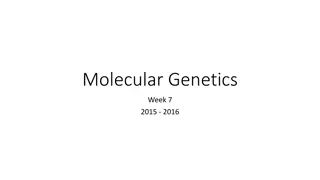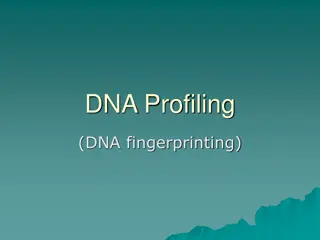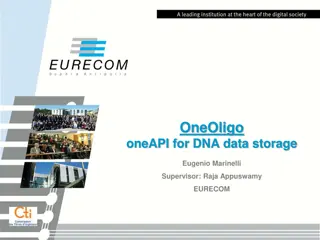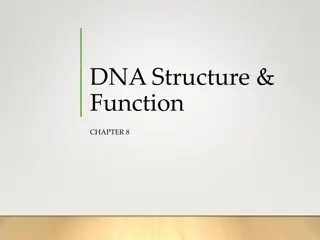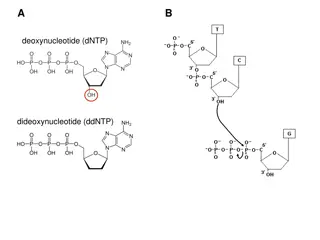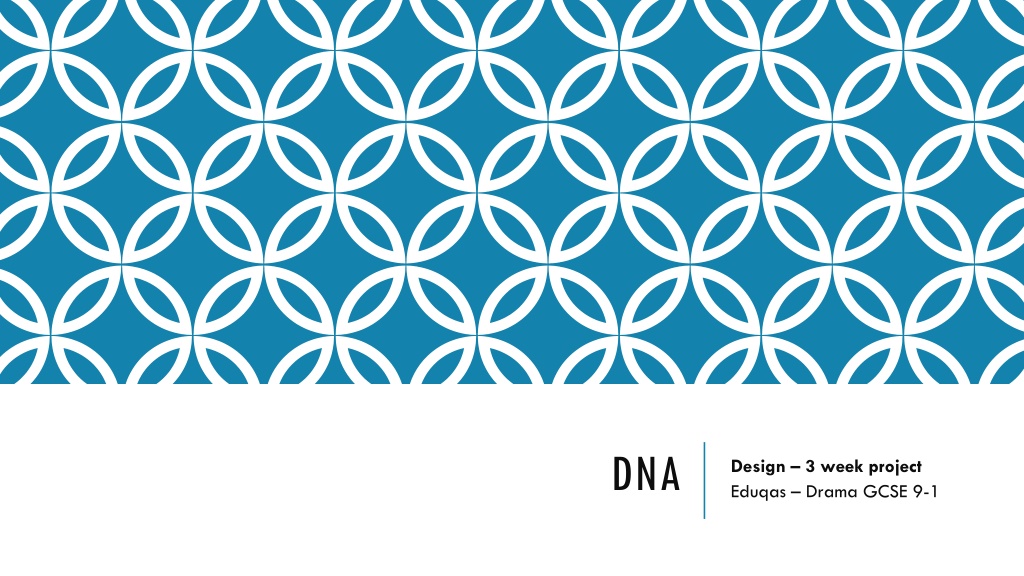
Set Design for Drama Productions: The Essentials
Enhance your knowledge on set design for drama productions with insights on creating outdoor locations, roles of set designers, selecting the right set, and the design process. Dive into the world of theatre design to elevate your understanding and execution of stage settings.
Uploaded on | 0 Views
Download Presentation

Please find below an Image/Link to download the presentation.
The content on the website is provided AS IS for your information and personal use only. It may not be sold, licensed, or shared on other websites without obtaining consent from the author. Download presentation by click this link. If you encounter any issues during the download, it is possible that the publisher has removed the file from their server.
E N D
Presentation Transcript
DNA Design 3 week project Eduqas Drama GCSE 9-1
THE BASICS There are three different locations in the play all of them outdoors; the street, the field and the wood. The scenes in the street are rather short. In these scenes the audience are made aware of what has been happening and are prepared for what will happen in the group scenes. Because they are short, the set must be minimal for a quick change of scenery before we move into the field and then into the wood.
DESIGNING A PRODUCTION Design has a huge impact on an audience s experience of a play as it s the first thing they see when the stage is revealed to them. The design provides essential information such as setting, period and the type of production you re seeing. There are a range of roles within theatre design which can cross over. There may be a team of designers working on a large scale production whilst smaller productions might only have one designer who works closely with the director. It's also important to consider the type of stage being used when deciding on set design.
SET DESIGNER ROLE Set designers usually take responsibility for props too. Their role involves making decisions about everything in and around the acting space, such as furniture, raised platforms or playing areas, entrances and exits, and the shape of the space itself. If the production has painted scenery the set designer may work with a scenic designer, who designs and paints scenery for the back or sides of the stage. Sometimes the two roles are combined.
SELECTING THE SET It s important that the choice of set suits the style of production and enhances it. The set designer must have an excellent working knowledge of the needs of the play. Their work involves creating multiple locations, sightlines for the audience and entrances and exits for the actors as well as dealing with any set changes that are needed. They must design to support the action rather than for design s sake. A set that is overly cluttered might detract from the action and make the actors job more difficult, rather than supporting them onstage.
THE PROCESS You would normally start with sketches of the set design. These must be detailed and are usually annotated. You should have a view from the audience as well as a birds- eye-view.
THE PROCESS When the choices have been made, they may build a scale model of the set, which is called a model box. This gives them an idea of what the real set would look like and lets them make any necessary adjustments.
THE PROCESS Once your model box has been approved by the Director and been discussed with the other designers working on the production, you can begin to build your set.
PROSCENIUM ARCH (Curtain)
ORIGINAL STAGING STYLE An interview with Simon Daw (the Original designer) What was the original stage type at the National? Thrust/End on? It was designed for the Cottesloe Theatre (now renamed the Dorfman) which can be configured in a variety of different ways (end on, in the round or thrust) but we performed it end on. It was in a season of other work that was also end on (and we had limitations on the time to change the configuration) but also because it worked well in relation to our desire to use projection. Why did you as the designer chose that stage design? DNA was part of a triple bill of plays (along with The Miracle and Baby Girl) all of which shared the same stage design. This was partly from a practical point of view, due to the limited time to do major changes to the set in the interval between plays, but also crucially conceptually we wanted to create a minimal design that all the plays would share. Central to this was the idea of using projection to help support the narrative but also to create a distinctive video design look for each play. The design consisted of an open square stage with a projection screen that appeared to float in the space at the rear of the stage. The stage surface was textured to look like black tarmac and was framed by a drain cover around the perimeter (in the play The Miracle the stage was wet with puddles as if it had just rained). For DNA the video had a forensic quality slowly moving through and exploring the spaces in which the play is set including a wood and a playing field. The three plays had quite a few different locations so the use of video allowed the action to flow uninterrupted by scene changes.
ORIGINAL STAGING STYLE How do you think the stage design enhanced the experience for the actors/audience? I wanted the design to really focus the audience attention on the actors and the narrative but also to provide an appropriate atmosphere for each scene, I think it achieved both. One of my favourite aspects of the design was how it explored the sense of these characters being somewhat isolated, killing time, alone in these space on the edge of a city. In one scene the video featured a blue sky and very slowly for the duration of the scene a tiny plane with vapour trails slowing crossing the void. If you could have staged it on a different stage type would you have? Why/why not? I think DNA would also work really well in the round or in traverse due to the intense psychological nature of it the piece. What elements of colour (lots of blue!) did you use to create mood and atmosphere? The photographs on my website probably looks a lot more blue than the actual production did due to the limitations of photography; certainly the video wasn t as blue as it appears on some of those shots! But having said that it was a very cool colour pallet. In the video I treated the footage so that a single colour e.g. the orange of a football goal net was heightened while colours around it we re more monochrome to help focus in on certain details. The costumes were also quite controlled greys, blues, white.
TASK You now need to create 2 different designs for the set for DNA (all 3 set locations). The first set of designs should be as close to the original design and staging as possible. The second set of designs should be set on a different staging type and should have a very different style to it. You MUST annotate all 6 designs with clear notes on colour, size, position, texture, and any other key information. You have this lesson and next to get these finished.
PRESENTING You must now present your ideas to each other. (The ones you created, not the originals.) Form a group of 4. 3 of you will be acting as the judges while the 4th person presents their set design. (Think Dragons Den). The judges will need to score the set design based on practical application, budget, visibility, appropriacy to the script, and general aesthetics. Once you have all taken it in turns and presented your ideas, you should decide whose is the best from your group and be able to explain why. The top one from each small group will now present to the class.
LIGHTING Lights can be useful for defining different locations on the stage, creating mood and atmosphere, highlighting key moments of action and directing the audience s focus. Lighting can denote time of year or day and can also be used in an abstract or symbolic way, such as using a red light to symbolise danger or passion. The lighting designer must also know the play very well. They work closely with the director to understand what they want to communicate in each scene and where the focus of the action onstage should be. They also work closely with the set designer, as they both play such a large role in the visual impact of a production. Often the realisation of the set designer s artistic vision depends greatly upon the way their set is lit. The lighting designer designs lighting cues. That means they decide when to move from one lighting state to the next. A sudden change to a different lighting state is called a snap and a slow change where one state overlaps another is called a fade.
LIGHTING Just like set design, the style of lighting must suit the production. A naturalistic production would not use symbolic lighting. A non-naturalistic piece might use lighting that was more abstract and stylised. Lighting is a very technical area and there are many types of lights (or lanterns). Coloured gels can be added to the front of some lanterns so that they throw coloured light onto the stage. Some can also be fitted with what is known as a gobo. This is a sheet inserted on a frame at the front of the light with a design cut into it. It filters the light, creating a picture effect on the stage. For example, a gobo could be used to create a dappled lighting effect to look like the leaves of a forest, or could be cut to create strips of light onstage which look like the bars of a prison.
THE PROCESS Read Script and Discuss with Director and Designer Initially, you should think about what the production needs, in very broad terms. If there s a moment set in a forest, for example, you could note that forest lighting will be required. If there s a scene in the living room of a house at night-time and early morning, that gives you two more elements of the palette to note down. A discussion with the set designer willl enable you to work together to ensure that the set can incorporate any ideas you have, and that the palette of ideas you re creating will cover the set designers ideas and wishes.
THE PROCESS Watch a rehearsal or run through. With the director sitting beside you watch and note actor positions and moves as relevant to the lighting. The director should let you know of any specific needs (I d like a snap blackout here, this actor should be isolated, I ll need the whole of this part of the stage to go pink here) and you should note them also.
THE PROCESS Produce the Cue List Having gathered all the information about the actors from the run-through, and all the artistic and colour decisions from the initial talk with the director and set designer, you now work through the show noting each point at which the lighting will change. This is potentially the most creative (and hence important) part of the process as you bring all the elements together for each scene of the show. Again, exact details aren t necessary; this list is to assure the director that you ve covered all the specific moments in the show that she/he s requested.
THE PROCESS Draw the Lighting Plan This is the point where the creative contents and ideas get translated into lanterns, using the cue list as a reference to check that the whole show has been covered. Draw a sketch plan with simple arrows where you know you need a light source. Label each arrow so that you can remember what it s doing. Once that s complete, think about which of the available lanterns you can use in each position. If you know you need hard-edged spots or gobo washes, that s an easy choice it has to be a spotlight.
THE PROCESS Lighting Rig The lanterns are hung in the rig, according to the positions drawn on the plan. The lighting designer should do a quick check that the lanterns are still going to do the creative job are they too close to where that bit of scenery will go, for example . Lighting Focus Lanterns are turned back into creative instruments, as the lighting designer decides where and how to focus the lanterns, to achieve the ideas of the palette.
THE PROCESS Lighting Plot Using the Cue list as a reference, director and lighting designer decide which elements of the palette are used at each point throughout the production, how the transitions are timed, and communicate the exact cue positions to the member of the stage management team who is on the book (usually the DSM). The moments between lighting states are of key importance and should be given adequate time. The way the lighting flows from scene to scene as it moves around the stage and through the play, can have a huge effect on the audience s perception of the quality of the performance. Technical Rehearsal The lighting designer refines cue positions and carries on plotting while the actors and stage management teams are rehearsing the show.
SPOTLIGHT A Spot has a hard-edged effect, used to light characters or elements on the stage. Coloured filters can be used with this lamp.
FRESNEL A Fresnel is used for a softer edged effect, with a diffusing lens in front of the lamp. It's useful for good overall light when used with others. Coloured filters can be used with this lamp.
FLOODLIGHT A Flood produces a clear wide-angled light, but there s little control over the spread of the light. Coloured filters can be used with this lamp.
STROBE LIGHT A Strobe is a flashing light, used for special effects. It s often used to give the effect of old movies. It produces a jerky effect on the movements of actors when used on its own.
PARCAN A Parcanis simply a can in which the PAR lamp is contained (hence Parcan ). Because the light produced can be very intense, Parcans are especially suited to strong colours or for special effect. Be aware that deep colours can burn out quickly at full intensity. Usually used to light set or stage areas.
TASK You now need to create a lighting plan and cue list for Act 4. The lighting plan should be detailed, have the name of every lantern you plan to use, the colour of each light and arrows should show where each lantern is pointing. The cue list should be written using a clear format that shows Stand-by and Go cues, as well as notes on what each cue will look like. You have this lesson and next to get these finished.
JUSTIFICATION You must now answer the two questions below - 1. As a designer, suggest three ways you could use lighting and/or sound to communicate the atmosphere in this extract. Give reasons for your suggestions. [6] 2. As a designer, choose one stage type and describe in detail your lighting design for Act 4. You should justify your ideas with reference to the original design choices. In your answer refer to: your choice of stage and audience position production style lighting states (including use of colour) [10]
MARKING Q1 1 mark per idea given to enhance the atmosphere through lighting and/or sound, up to a maximum of 3 marks. 1 mark per explanation, up to a maximum of 3 marks. The mood is full of tension, insecurity and aggression. The atmosphere is fraught because of the underlying tension between the characters. Lighting and sound ideas plus explanations, possible responses include: Use of cold gels and possible shadows. Gobo to represent woods. Colour to represent setting. Use of projections as linked to style Brechtian / TMA. Indication of the strength/intensity of the lighting. Fade up lighting from a blackout. Lighting change to create tension. Perhaps use of backlight, colour. Special effects such as strobe. Sound effects could enhance the tension at the beginning and set the scene. Use of non-naturalistic sound effects to create tension e.g. heart-beat.
MARKING Q2 9-10 marks Design concept is fully explored demonstrating a high level of knowledge and understanding of how this can be designed for their stage type. / Perceptive and detailed explanation of chosen production style. / Highly detailed description of the lighting (including the use of colour). / Highly detailed examples which fully support the design are presented. / Highly relevant knowledge, understanding and use of drama terminology. 7-8 marks Design concept is explored demonstrating a knowledge and understanding of how this can be designed for your stage type. / Detailed explanation of chosen production style. / Detailed description of the Lighting (including the use of colour). / Detailed examples which fully support the design are presented. / Relevant knowledge, understanding and use of drama terminology. 5-6 marks Design concept is generally explored demonstrating a knowledge and understanding of how this can be designed for your stage type. / General explanation of chosen production style. / General description of the lighting (including the use the use of colour). / General examples which support the design are presented. / Generally relevant knowledge, understanding and use of drama terminology. 3-4 marks Design concept is partially explored demonstrating some knowledge and understanding of how this can be designed for your stage type. / Some explanation of chosen production style. / Some description of the lighting (including the use of colour.) /Some examples which support the design are presented. / Some relevant knowledge, understanding and use of drama terminology. 1-2 marks Design concept is referred to demonstrating limited knowledge and understanding of how this can be designed for your stage type. / Limited explanation of chosen production style. / Limited description of the lighting (including the use of colour). / Limited examples which support the design are presented. / Limited knowledge, understanding and use of relevant drama Terminology. 0 marks No work worth marking
SOUND DESIGN The sound designer is responsible for how a production sounds beyond the noise the actors make. Sometimes the sound designer is responsible for music too, but usually music and sound design are separate roles. It depends on the requirements of the show. A production with a lot of live or incidental music might have a separate composer, who writes original music for the production or a musical director, such as in Musical theatre. Some shows use a lot of sound effects and it's the sound designer s job to decide what should be added where to enhance a production. They must then source the sounds and plan when they come in, when they stop and what volume level they should be at for best effect. If the sound designer operates the sound during performance they will have headphones so that they can check the sound effect or piece of music played is cued up and ready to play at the right time. A loud sound effect coming in at the wrong moment could spoil a scene and break the theatrical illusion.
SOUND DESIGN Once again, the artistic choices the sound designer makes will depend on the style of the production. Just like lights, sound can be used effectively to create atmosphere and location, such as adding a faint sound of birdsong under a scene set in a garden. Sound can also be used in an abstract way. For example, you could choose sounds which reflect the emotions of the characters onstage or a sound that creates fear or builds tension, eg a repetitive ticking noise that increases in volume throughout a scene. Music may also be used to create mood and atmosphere. Playing it underneath the action onstage in this way is called underscoring. Choice of music is very important. You must decide if it should be live or recorded and consider whether it improves the work or if a scene would be more powerful without it.
PROCESS Mood and atmosphere is the feeling that the production creates for the audience. Sound is very significant in creating mood and atmosphere, and audiences will associate different sounds with different moods. Mood and atmosphere can be created through the use of music or through a soundscape or choice of sound effects. Moods and atmospheres can also be achieved through the alteration of sounds, for example adding reverb or echo. When you consider a sound design, ask yourself whether the sounds are there to indicate a specific time or location, whether they are creating a specific atmosphere or mood for the audience, or whether they are doing both: sometimes a playwright or director uses a certain location or time deliberately to create a mood or atmosphere, and this could be reflected in the sound design.



